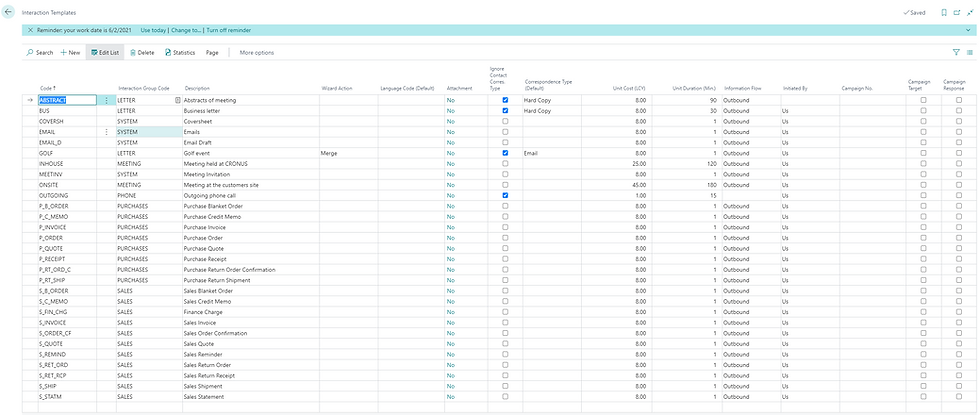How the Relationship Management Features of Business Central Can Help Manage Your Sales Efforts
- Corry Greenbaum
- Jul 7, 2021
- 3 min read
Updated: Oct 15, 2021
While relationship management isn’t typically the reason why prospects reach out to us to get a demo for Business Central, within the product is a set of powerful tools that can enable a level of productivity not seen in other ERPs. Living up to it’s name, Business Central’s relationship management system grabs data from other Microsoft products that you may already be using and enhances that functionality. Leveraging a common back end with Dataverse, whether customers or sales are created in Business Central or Dynamics 365 for Sales, they can be managed and synced across platforms. Unsiloing data from Microsoft’s industry leading CRM enables other departments to gain key insights from sales activities, not possible with other ERP/CRM pairings.
Managing Interactions with Contacts
Recording interactions with contacts is very important in this day and age. Managing those interactions across platforms and mediums is something that is vital to an agile sales process. After all, receiving a call, an email and a letter in the mail all advertising the same campaign is a sure-fire way to have a customer ignore your communications as something the have already heard. Instead of shooting messages into the dark, unsure which prospects have been contacted, Business Central gives sales-focused businesses the tools to manage their relationships from start to finish. The first step within Business Central contact management is establishing a way to work with contacts with interaction templates.

Here we can specify how we will interact with prospects across the organization. From sales and purchase documents in accounting, to email templates; there is a large amount of flexibility within Business Central to begin tracking data. We can also track how much it costs our business to produce different kinds of interactions, enabling ROI metrics to be produced on all interactions. Once we have specified a few ways we would like to interact with the customer, we can move on to creating interactions within Business Central.
Some interactions are automatically recorded by the system with no action necessary from the user. Calling one of your contacts in Business Central from your TAPI-Compliant work phone would automatically be recorded by the system once interaction templates have been enabled. Sending emails to contacts and printing sales/purchase documents from the system are also included as automated features. If an interaction was not automatically tracked by the system, those interactions can be recorded manually. This is also a great way to set up future actions, such as creating a follow-up, or postponing a sales call to a more opportune time for the customer.
Managing Sales Opportunities
In sales, any incoming interaction can be a potential sales opportunity. Creating opportunities and managing them within Business Central is an important way to increase win-rates as a business. Like most things in Business Central, Sales begins with configuration. Setting up the steps for a sales opportunity to go down is pivotal to a successful sales cycle.

From the Sales Cycle page in Business Central, we get an overview of the different Sales Cycles that have already been set up within the system. Selecting ‘Stages’ gives more in-depth process guidelines, from lead qualification to close.
Once our cycles have been configured, we can begin adding opportunities into the system.

Within an opportunity, give a description, and an approximate value of the opportunity for sales analysis at a glance. Diving into an opportunity, there is tons of room for a sales person to express how the opportunity is going, and what actions have occurred.

In a win or loss, a sales manager is presented with the raw data to understand what steps were taken to close the deal one way or another. If the sale was a part of a campaign, campaign pricing can be used to evaluate the value of an opportunity, and returning back to our initial configuration the Sales Cycle Code “Existing” (For existing customers) was used to close this business successfully.
Questionnaires to Classify Business Contacts
Questionnaires within Business Central allow sales people the flexibility to quantify leads with information that they already have, or send out questionnaires to prospects that may be warm and ready for additional communication.
Within the questionnaire, we can specify different qualifications based on their answers. Qualifying different groups of customers, can then be used to feed separate sales processes that are tailored to be more successful based on the information that we have gathered from our prospects.
If you would like to learn more about configuring Relationship Management in Business Central please contact us and one of our consultants will be happy to help.

Comments